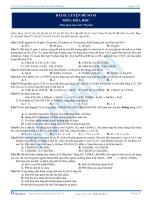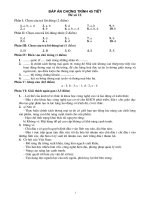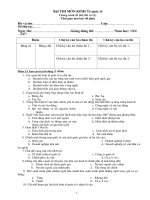PASSAGE 11
Bạn đang xem bản rút gọn của tài liệu. Xem và tải ngay bản đầy đủ của tài liệu tại đây (33.63 KB, 2 trang )
PASSAGE 11
THE GOIDEN ACHE OF COMICS
The period from the late 1930s to the middle 1940s is known as the Golden Age of comic books. The
modem comic book came about in the early 1930s in the United States as a giveaway premium to
promote the sales of a whole range of household products such as cereal and cleansers. The comic books,
which were printed in bright colors to attract the attention of potential customers, proved so popular that
some publishers decided to produce comic books that would come out on a monthly basis and would sell
for a dime each. Though comic strips had been reproduced in publications prior to this time, the Famous
Funnies comic book, which was started in 1934, marked the first occasion that a serialized book of
comics was attempted.
Early comic books reprinted already existing comic strips and comics based on known characters;
however, publishers soon began introducing original characters developed specifically for comic books.
Superman was introduced in Action Comics in 1938, and Batman was introduced a year later. The
tremendous success of these superhero comic books led to the development of numerous comic books on
a variety of topics, though superhero comic books predominated. Astonishingly, by 1945 approximately
160 different comic books were being published in the United States each month, and 90 percent of U.S.
children were said to read comic books on a regular basis.
Question 1. It can be inferred from paragraph 1 that, at the beginning of the 1930s, comic books most
likely cost _________.
A. nothing
B. 5 cents
C. 10 cents
D. 25 cents
Question 2. Comic books would least likely have been used to promote _________.
A. soap
B. cookies
C. jewelry
D. bread
Question 3. It is implied in the passage that Famous Funnies _________.
A. was a promotional item
B. appeared in a magazine
C. had been produced prior to 1934
D. was published on a regular basis
Question 4. From the information in paragraph 2, it appears that Superman most likely _________.
A. was introduced sometime after Batman
B. was a character that first appeared in a comic book
C. first appeared in Famous Funnies
D. first appeared in a promotional comic strip
Question 5. It is implied in paragraph 2 that it is surprising that _________.
A. comic strips were more popular than comic books
B. superheroes were not too popular
C. 90 percent of U.S. children did not read comics
D. comic books developed so quickly
Page 1
ĐÁP ÁN
1-A
2-A
3-D
4-B
5-D
LỜI GIẢI CHI TIẾT
Question 1:
Dịch nghĩa: as a giveaway premium – như một món thưởng
Question 2:
(lines 3-4; as a giveaway premium to promote the sales of a whole range of household products such as
cereal and cleansers)
Dịch nghĩa: Như là một phần thưởng để xúc tiến sự bán của cả loại hàng gia dụng như ngũ cốc và chất tẩy
rửa
Question 4:
(lines 12-14; publishers soon began introducing original characters developed specifically for comic
books. Superman was introduced in Action Comics in 1938, and Batman was introduced a year later.)
Dịch nghĩa: Các nhà xuất bản sớm bắt đầu giới thiểu các nhân vật nguyên bản được tạo ra đặc biệt cho
truyện tranh. Superman được giới thiệu trong Truyện tranh hành động năm 1938 và Batman được giới
thiệu 1 năm sau đó.
Question 5:
(the last sentence; Astonishingly, by 1945 approximately 160 different comic books were being published
in the United States each month ... )
Dịch nghĩa: Thật đáng kinh ngạc, năm 1945 có xấp xỉ 160 cuốn truyện tranh khác nhau được xuất bản
mỗi tháng ở Mĩ
Page 2









